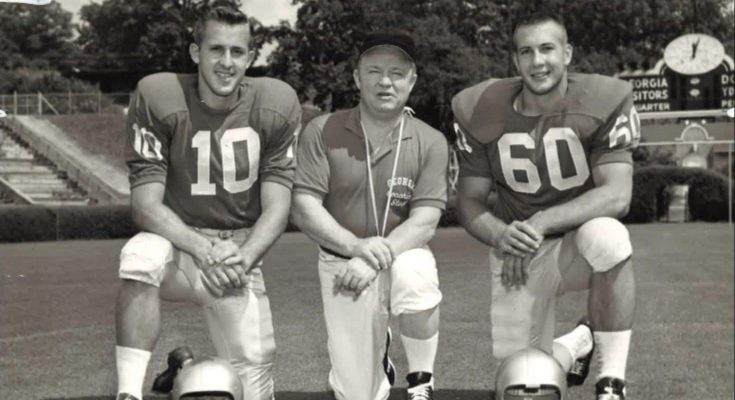“Legends in the Making: Fran Tarkenton, Pat Dye, and Bobby Walden Led Wally Butts’ 1959 Georgia Bulldogs to SEC Glory and Orange Bowl Triumph”
The 1959 Georgia Bulldogs football team remains one of the most iconic squads in the long and storied history of SEC football, not only for their stellar on-field performance but also because of the legendary names that anchored the roster. Under the guidance of head coach Wally Butts, a stalwart of Georgia football history, the Bulldogs authored a season that remains a reference point of excellence in Athens. With quarterback Fran Tarkenton and guard Pat Dye serving as team captains, and standout halfback and punter Bobby Walden from Cairo, Georgia, contributing heavily, the Bulldogs stormed through their schedule to capture the SEC championship and cap the year with a shutout win in the Orange Bowl. The narrative of this team is not just about victories and statistics—it’s about the foundation they laid for the legacy of Georgia football and the enduring greatness of the men who wore the red and black.
Wally Butts, who had already established himself as a coaching icon by the late 1950s, returned to prominence with this squad after several middling seasons. Butts’ legacy had previously been cemented with Georgia’s 1942 national championship team led by Frank Sinkwich and the 1946 squad with Charley Trippi, but the 1959 season offered a resurgence that showed he could still build and lead championship teams more than a decade later. It helped that Butts had two natural-born leaders in Tarkenton and Dye. Tarkenton, a cerebral and mobile quarterback who would later become an NFL Hall of Famer, gave the Bulldogs poise, vision, and leadership under center. Pat Dye, who played with the grit and tenacity that would later define him as one of college football’s legendary coaches, was the heart of the line, offering protection and physical dominance in the trenches.
Georgia’s 1959 campaign began with momentum and confidence. With Tarkenton’s field command and Dye anchoring the offensive line, the Bulldogs played fundamentally sound, opportunistic football. Bobby Walden, meanwhile, became an indispensable weapon for Georgia. A halfback with uncanny punting abilities, Walden could flip field position like few others, giving Georgia’s stout defense room to operate and limiting opponents’ chances of scoring. Walden’s unique skillset would later make him a star in both the CFL and NFL, but in 1959, he was the ultimate X-factor for Georgia.
The Bulldogs rolled through their schedule with only one blemish—an early-season loss to South Carolina. But instead of unraveling, the team responded with incredible resolve, ripping off seven straight wins in conference play. They beat traditional rivals and SEC foes with discipline and creativity, including crucial victories over Auburn, Florida, and Georgia Tech. The offense was efficient and the defense stingy. Tarkenton executed Butts’ pro-style passing system with remarkable maturity, and Dye’s presence on the field was like having a coach in pads. Walden’s punting ensured that even when drives stalled, Georgia didn’t lose momentum.
By the end of the regular season, Georgia stood tall with a 10–1 record, undefeated in SEC play at 7–0. That perfect conference mark earned the Bulldogs their first outright SEC title since 1946, a major achievement given the dominance of schools like Ole Miss, LSU, and Tennessee during that decade. Their dominance caught the eye of bowl selectors, and Georgia was invited to play in the Orange Bowl against the Missouri Tigers, champions of the Big Eight Conference. It was a marquee matchup between two of the best teams in the nation.
The 1960 Orange Bowl, held on January 1st, offered Georgia a national stage to validate their SEC dominance. They did not disappoint. The Bulldogs delivered a masterpiece, defeating Missouri 14-0. Tarkenton was composed and clinical, directing two scoring drives with a precision that made him stand out even among elite college quarterbacks. One of the game’s defining moments came when Tarkenton connected on a key third-down pass that sustained a drive, ending in a touchdown that effectively sealed the game. Missouri never found an answer to Georgia’s balanced attack and were consistently pinned deep in their own territory by the booming punts of Bobby Walden. Meanwhile, Dye and the offensive line won the battle in the trenches, wearing down Missouri’s front and controlling the pace of play.
The shutout victory not only gave Georgia a prestigious bowl title but also pushed them into the national conversation. While they didn’t claim a national championship in the polls, their season remains one of the greatest in program history. The Orange Bowl win was symbolic not just for the trophy, but for what it represented—a team that combined elite talent, cohesive leadership, and impeccable coaching to deliver a season of near-perfection.
Fran Tarkenton’s performance throughout the 1959 season solidified his reputation as one of the greatest quarterbacks in Georgia history. His football IQ, agility, and improvisational skills made him a nightmare for opposing defenses. Those same traits would carry him through a legendary NFL career with the Minnesota Vikings and New York Giants, culminating in an induction into the Pro Football Hall of Fame. Tarkenton remains a revered figure not just in Athens, but in football circles worldwide.
Pat Dye’s legacy was only beginning in 1959. His rugged, disciplined approach to the game would later define his tenure as a head coach, most notably at Auburn, where he led the Tigers to four SEC championships and became one of the most respected coaches in college football history. But it was at Georgia where he first learned what it meant to lead, and his contributions to the 1959 team are part of that enduring foundation. Dye’s playing days gave him the toughness and vision that would guide him throughout his coaching career.



